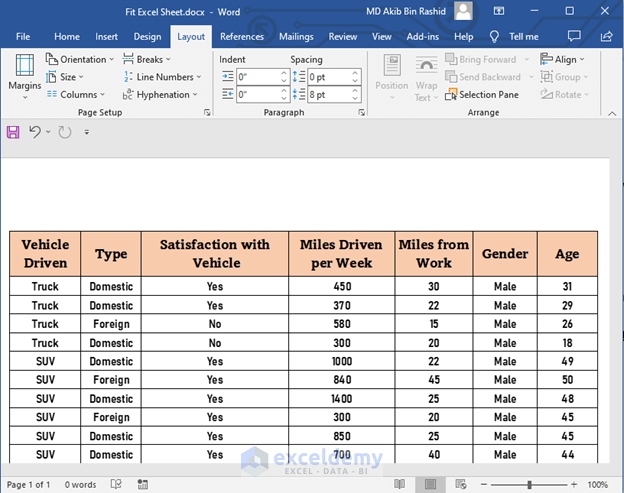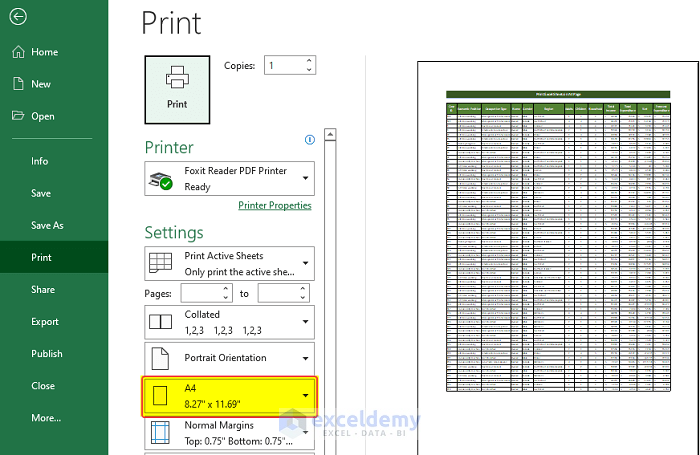5 Tips to Fit Excel Sheet on One Page

Adjusting Margins for Optimal Print Layout

Before you start adjusting your Excel spreadsheet to fit on one page, it's crucial to manage the margins effectively. Here are detailed steps on how to:
- Open the Page Layout Tab: Click on 'Page Layout' to access settings that control how your document looks when printed.
- Navigate to the Margins Option: Within the 'Page Setup' group, find and click on 'Margins'.
- Customize Margins: From the dropdown menu, select 'Custom Margins'. A new window will appear where you can manually adjust the margins:
- Set top, bottom, left, and right margins to 0.25 inches or even less if necessary.
- Reduce Header and Footer Margins: Decrease these to 0.25 inches or less to conserve space.
- Confirm Changes: Click 'OK' to apply the new margin settings.
⚠️ Note: Ensure your printer can handle smaller margins without cutting off data. If your printer doesn't support the chosen margins, your spreadsheet might not print correctly.
Modifying Page Orientation for Data Layout

Page orientation significantly affects how data is displayed when printed. Follow these steps to change the orientation:
- Go to the Page Layout Tab: This is where you'll find print-related settings.
- Change Page Orientation: In the 'Page Setup' group, click on 'Orientation' and select:
- Landscape for wider data sets with many columns.
- Portrait for narrower data with more rows.
- Preview the Layout: Use 'Page Break Preview' to see how your data will be spread over pages.
By altering the page orientation, you can fit more columns or rows onto a single page, thus reducing the number of pages required.
| Orientation | When to Use | Advantages |
|---|---|---|
| Landscape | For wide datasets or reports with numerous columns |
|
| Portrait | For narrow datasets or when you have more rows than columns |
|

Scaling Down Data to Fit One Page

If adjusting margins and page orientation isn't sufficient, consider scaling your sheet:
- Access Scale to Fit: In the 'Page Layout' tab, locate 'Scale to Fit'.
- Set Scale: Reduce the scale percentage until your data fits on one page. Remember:
- Excel will automatically adjust to fit your data, but excessive scaling can result in readability issues.
- Ensure the scale doesn't reduce text size too much, making it difficult to read.
- Check Print Preview: Before finalizing your changes, always review in 'Print Preview' to confirm that all necessary data fits onto the page.
🔍 Note: Scaling down the page can sometimes make the text very small. Ensure that important data remains legible and accessible to your audience.
Formatting and Hiding Elements for Conciseness

To further compact your Excel sheet:
- Shorten Headers and Labels: Use concise labels to maximize space on the page.
- Hide Unnecessary Rows/Columns: Right-click on rows or columns and choose 'Hide' to eliminate clutter from your printout.
- Merge Cells: Consider merging cells with repetitive data to reduce the number of cells and thus conserve space.
- Use Cell Alignment: Align your data appropriately to reduce the space each cell occupies.
By adopting these methods, you can make your Excel sheet not only fit on one page but also look organized and professional.
Optimizing Printing Settings for Efficiency

Here are some Excel settings to review for efficient printing:
- Print Area: Define a specific print area to print only what's needed.
- Print Titles: If your data spans multiple pages, repeat row or column titles on each page to maintain readability.
- Print Selection: Highlight and print only the required data instead of the whole sheet.
- Ignore Print Errors: Choose to not print errors or blank pages for a cleaner output.
By adjusting these settings, you ensure your sheet prints exactly as intended, minimizing waste and ensuring clarity.
In wrapping up, making your Excel sheet fit on one page involves a combination of margin adjustments, changing page orientation, scaling, formatting, and optimizing print settings. These steps help in organizing your data in a concise yet clear manner. Remember, the key is to strike a balance between fitting the data on one page and maintaining readability for your audience.
What if I still can’t fit all the data on one page?

+
Consider using the ‘Fit to Page’ option, which will automatically scale down your data to fit. However, if readability becomes an issue, consider summarizing data or using multiple pages with clear headers and labels on each.
How can I ensure that all important data is visible when scaled down?

+
Preview your spreadsheet in ‘Print Preview’ mode. If data is too small or cut off, you can adjust the scaling manually or use ‘Page Break Preview’ to rearrange your data.
Does scaling down the sheet affect the data’s accuracy?

+
No, scaling down only changes how the data is displayed when printed, not the actual data itself. Your numbers, calculations, and formulas remain accurate.
Can I revert the changes made to my Excel sheet’s layout?

+
Yes, Excel allows you to undo changes with ‘Undo’ (Ctrl + Z). Alternatively, use ‘File’ > ‘Save As’ to create a new version of your document before making changes, preserving the original layout.